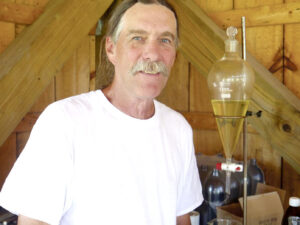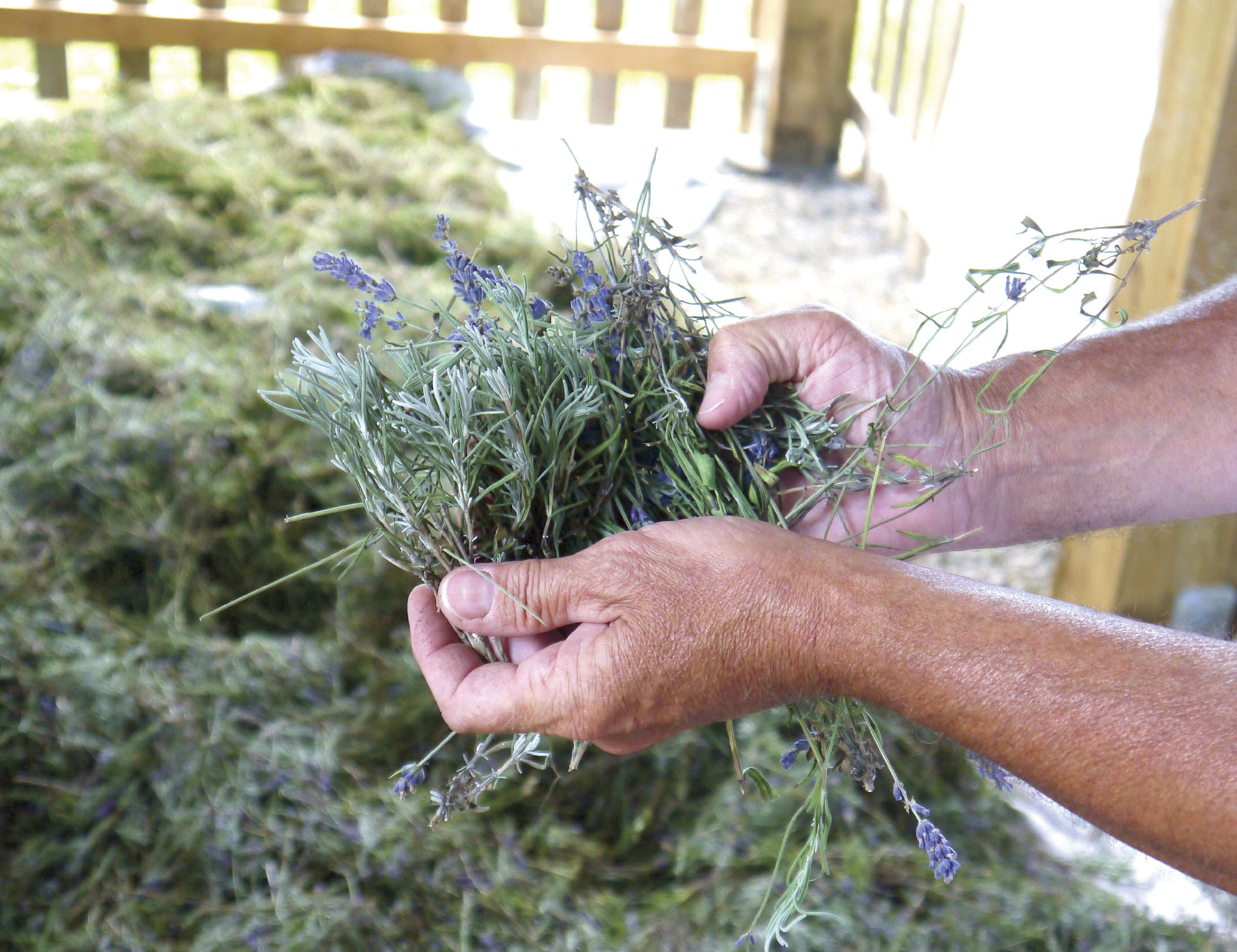County News
Lavender harvest

Steam extraction process produces essential oils
When the lavender fields at Prince Edward County Lavender finish blooming in early summer, harvesting ensues, and what follows is pure magic. That magic involves a touch of science, lots of patience, plenty of cut lavender, and a steam extraction process that fills the open barn with a delicate, penetrating lavender aroma. The incredibly simple process uses the lavender flowers, including leaves and stalks, to yield essential oil. It’s not quite something out of an old school science laboratory, and as primitive as it looks, it performs the task well, extracting the oil from the harvested plant material. While it’s often referred to as a distillation process, it’s technically an extraction system using steam, but it’s one people are fascinated by, says Derek Ryles, co-owner of PEC Lavender. “We are not really distilling anything, we are merely using steam to extract the oil, and the equipment that we use looks vaguely like a distillation operation, but it’s not because distilling typically involves fractioning something, removing a segment of your product.”
Harvesting at the lavender farm is now mechanized for the first time, and while it was a big investment in equipment, albeit a constructed system incorporating a hedge trimmer (to cut the flowers) and a vacuum (a large-scale leaf shredder) that vacuums the plant material into a holding bin, Ryles says it will not only pay off over time, but it will save on labour, something he says is getting harder to find in the area. “We harvested the back field with our new harvester and it took about seven to eight hours on the tractor to harvest that entire field for two people,” he says. “It’s a real leap forward for us in terms of technology. Instead of taking three guys, 10 to 12 days to harvest that amount, we did it basically in one day with two people.” He says it now means they can pick the perfect day to harvest, and “that will hopefully improve our yields.”
PEC Lavender have been harvesting lavender and producing essential oils for about 13 years. While they started out with just lavender, essential oil production has included lemon verbena, basil and spearmint. “Our staples would be the lavender, and over those years has included lavender hybrid lavandin, also sage, thyme and oregano oils are our main ones and sometimes peppermint,” he says. While this year wasn’t a good flower year for the farm, due to the long cool spring, in a perfect year they can harvest two tons of flowers.

Derek Ryles, co-owner of PEC Lavender, distills lavender oil using the steam extraction process.
The system they have adopted for the essential oil production is a steam extraction process where steam is generated externally and is introduced into a large retort (a vessel for distillation) where the lavender or plant material is stored. “The steam passes through that and the heat and the moisture will extract the essential oil and that becomes vaporized in the steam,” explains Ryles. “We collect all of that steam, we condense that and the steam returns to the liquid state, as does the oil, and they separate out in the container we are capturing that in.”
All of the essential oil produced at the farm is 100 per cent essential oil directly from the plant, with nothing added. “We are merely using steam to extract it from the plant and it is basically the oil that the plant would express,” he explains. “In the case of lavender and most of the plants that we are growing for oil, they are all the lamiaceae family which would be considered the woody herbs, which include rosemary, sage, thyme, oregano, lavender and the whole mint family, among others.” In most cases, the oil is secreted by the plant on little glands on the surface of the leaf or the flower. “What we are doing by heating it and exposing it to the steam, we are rupturing those glands and the oil is vaporizing and mixing with the steam which is then collected.” Timing is critical, and they have a small window of time to complete the process. “If you are two weeks late or two weeks early, your yield would be 10 per cent of what it could potentially be,” he says. “In the case of lavender, what we are looking for is flower development and flower maturity: as soon as the flower heads have developed one would see the florets, the calyx, actually diverge from the axis of the stalk and they begin to dilate and they are about to release the petals, the corolla of the flower.” Harvesting begins when it’s about 30 per cent flower open and continues until all the flowers, all the corollas, have opened. “That way we capture the peak yield.”
Once the lavender is harvested in the morning, the ‘distillation’ process is usually completed the same afternoon because the plant loses moisture as it dries. “That’s actually a good thing because when you go to process it, you don’t need as much energy to heat it up.” Ryles explains that if the weight of the plant material is reduced by 50 per cent, it becomes a much quicker extraction. However, he notes that essential oil is also lost because the plant ceases to produce the oil and it is also evaporating from the plant. He notes the same steam extraction process is also used for producing essential oil for mint and other herbs, so they are running the process from early June into early August, usually beginning with sage, then oregano, and mint comes after the lavender.
Once the essential oil has been extracted, the lavender oil must be aged for one year, a mandatory part of the process, because the initial smell is astringent and very harsh. “After eight to 10 months it really softens and begins to take on that traditional lavender scent and then after a year, it is deemed ready to use.” The trick to storing essential oil is to keep it from oxidizing, so the amber bottles must be filled to the top and stored in a cool dark place where they should last for three years or more without degradation. The lavender farm has their oils tested off-site using gas chromatography testing to determine the constituent parts. “All our oils have met the ISO standard, which makes us pretty happy.”
With each lavender cultivar bringing a different aroma profile—some are very perfumey, some very strong, others middle of the road—they blend them together for the ideal recipe. While they offer a range of pure essential oils for sale, the oils are also used to scent a number of products they make, such as all the bath and body products, and many of the culinary items too. And it doesn’t take very much for that magic to work. “It’s a very minute amount, we are talking drops per kilogram, and one drop extra per kilogram and it’s almost over the top, so it takes quite a while to arrive at our dosing rates, but it’s miniscule.” Prince Edward County Lavender is located at 732 Closson Road, Hillier. The boutique is currently open Thursday to Monday (closed Tuesday and Wednesday) from 10 a.m. to 5 p.m. The online store, offering a wide range of products, is open year-round at peclavender.com.


where do you store the freshley reaoed lavender ptior to the steem and extraction prosess